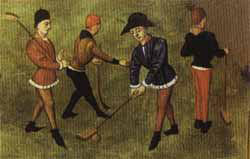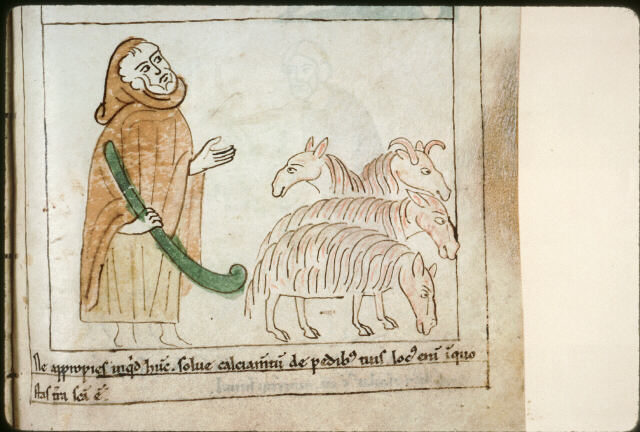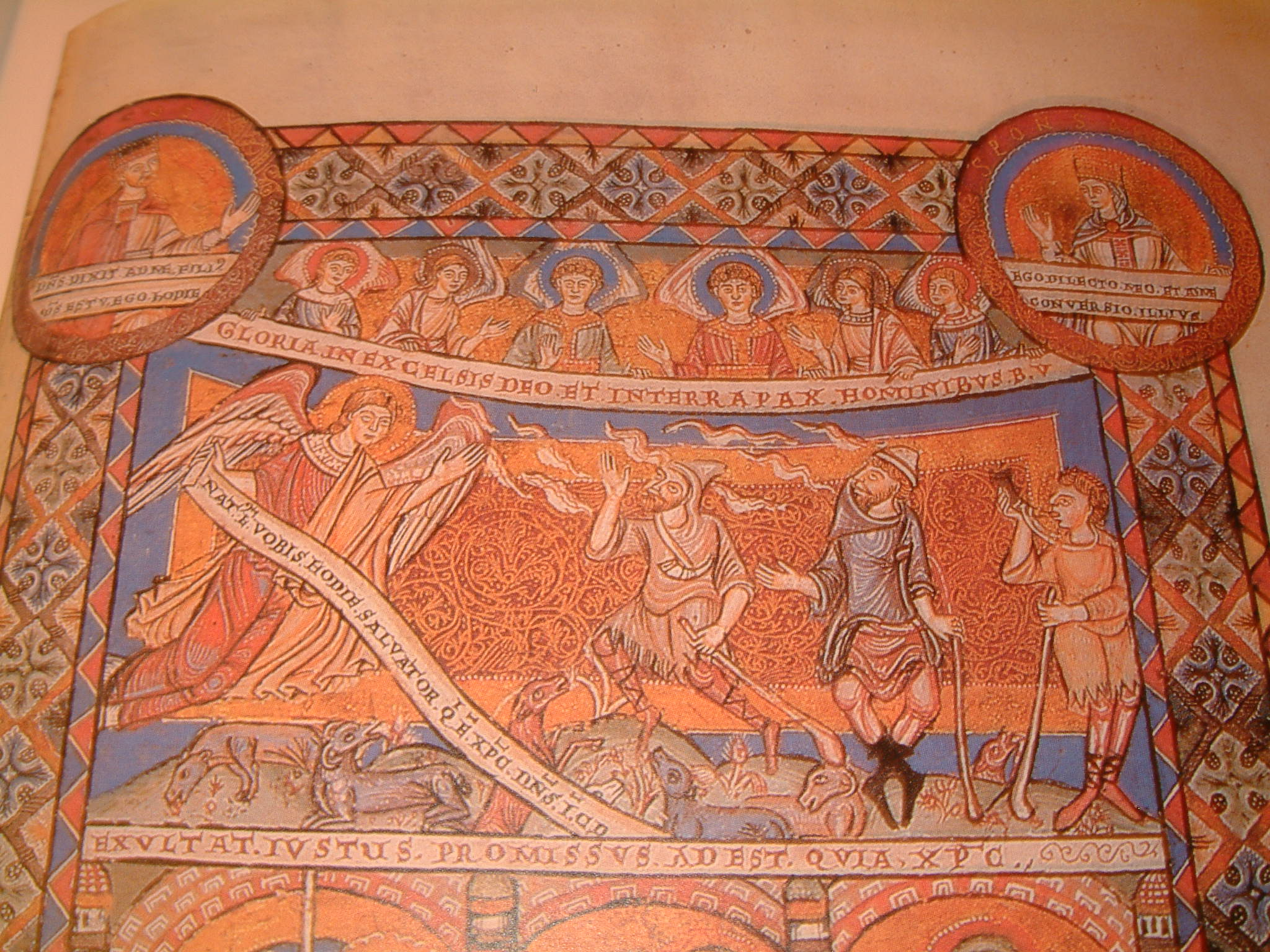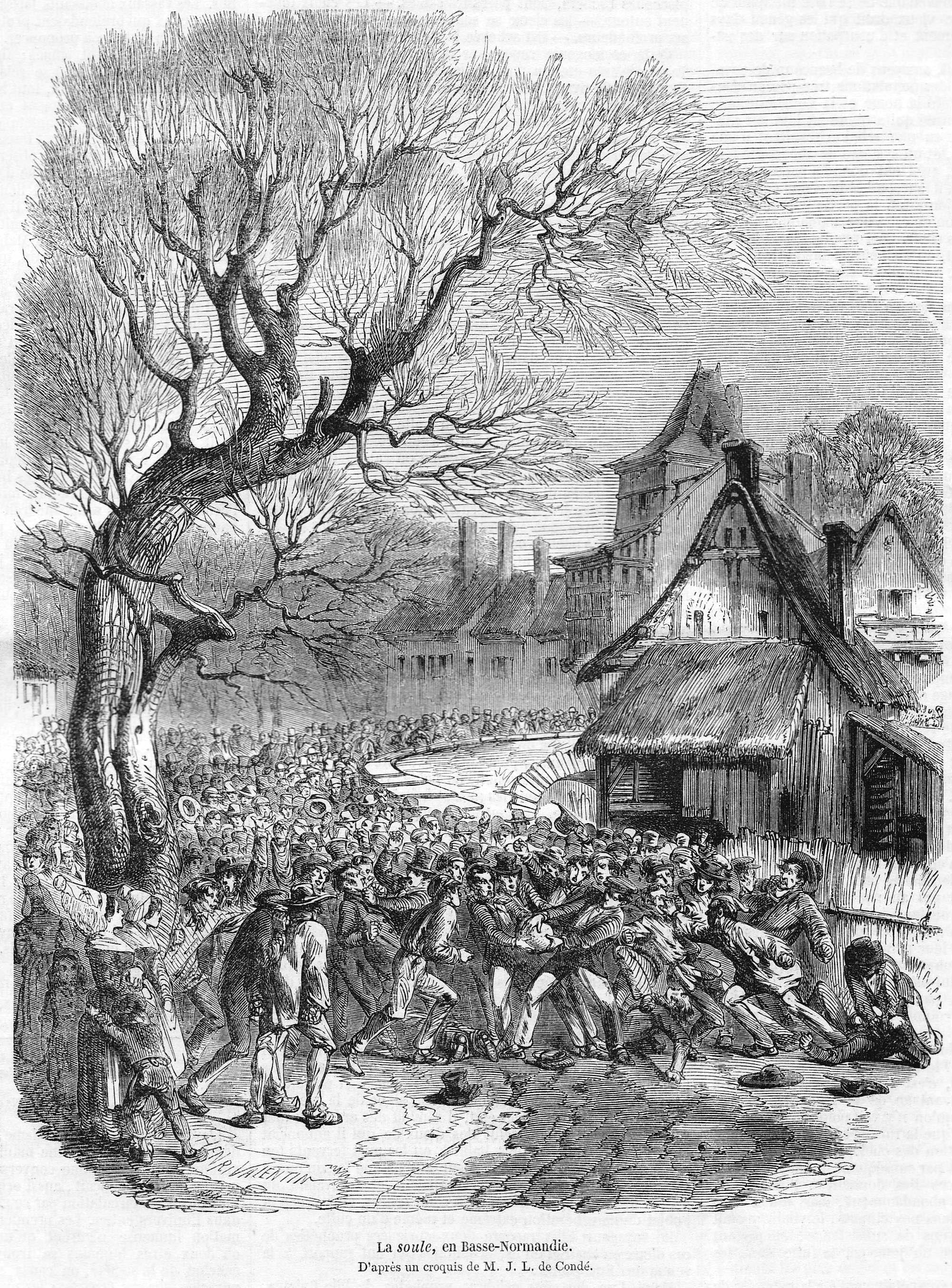
La soule à la crosse (France)
- Name of sport (game): La soule à la crosse
- Name in native language: La soule à la crosse (chôle in picard, choule in normand)
- Place of practice (continent, state, nation):
Soule is a traditional sport practiced historically mainly in North-West France, as well as in the Southwest.
- History:
It would seem that in the 12th and 13th century Europe (information appears in a book published in Paris during this period), sport was reserved for the nobility or the clergy, that is, for people who had the most time. It turns out, however, that "those who work" also had their physical activity when they had time. One of them has been practiced since the Middle Ages: la soule à la crosse.

Bibl. Municip. d’Amiens, ms. 0108, f.041
In France as in Albion, Charles V will proscribe the soule, for two reasons, on the one hand of course because of the reports that are made on the violence and the physical damage caused by the soule, but especially, for him, it turns the people away from the bow and crossbow training that they had brought back to the taste of the day, thus justifying the defense of the kingdom.

Evangéliaire d’Henri le Lion, 1187-1188
There were no real rules in this game, moreover the majority of the striking people could not read or write, but the oral tradition imposed some guidelines of games.

The soule in Lower Normandy in 1852 - in „L'Illustration” February 28, 1852
The rules were very changeable. One of the forms of the game was similar to the current golf, while others were closer to the hockey. This last version of the collective sport is practiced in Brittany until the 19th century, and in Normandy until the end of World War II. The last oral messages came from Cotentin (1943 Bricquebec (Cotentin) and later 1945 in Saint-Vaast (Cotentin).
Formerly, this sport was mainly cultivated from Christmas to the day of Saint. John, during the patron saints and during the carnival.
There are links of this sport with ancient Roman sports (harpastum), then calcio florentin in Quattrocento Italy, Scandinavian (knattleikr) or hurling (renaissance from the beginning of the 20th century) and Irish Gaelic football, Scottish shinty, but also with more modern or less traditional sports : American and Australian football, Canadian Lacrosse.
This sport is the theme of the film "La Soule" by Michel Sibry (1989) with Richard Bohringer and Christophe Malavoy. - Description:
This is a sport that involves moving the ball to the place marked as the goal. Two teams have the same goal (place the ball in a specific place), and their composition had no defined limits (originally teams consisted of all important men from two or more villages / married and not married). The game was started with the ball throw of the last bride of the year), and the ball can move in all directions. We have no other information about any additional rules. In short, it would be a medieval version of hockey.
He who held the ball could only be attacked by one person at a time and it was forbidden to hit under the belt. It was the rural game par excellence, which requires no particular terrain.
We play on the village square, a field, a clearing or on the banks of a river. Natural obstacles such as hedges, ponds and streams or small walls are small supplements that add flavor to the game.
Many people could play: adults, children 6, priests (for example, Archbishop Rouen Eudes Rigaud (around 1205-1276) was indignant in 1248 by the behavior of his diocesan priests playing in ... It also seems that the players were only men. It is certain that the game is difficult, but violence does not seem to be tolerated.We find several variations of the game of Soule. It was a ball or balloon, either of wood or leather, in the latter case it was furnished with hay, bran, moss or even hair of various animals.
The soule was struck by the hand, the fist or the foot, if it was wooden as mentioned above we used wooden sticks, which gives us already four variants of this game: by hand, with the foot, with the two and to the stick. Each region had its preferences because it was played everywhere in France.
The stick is made of birch branches. The handle is rounded, the part used to hit the ball is flattened.
Balls could be made of wood, sometimes made of leather, filled in the latter case with hay, bran or foam or inflated with air. A ball filled with hay has the advantage of being less dangerous for participants. A wooden ball is easier to use in the game, but it is more dangerous.The main feature of this game is the struggle, often violent between two groups, and the spontaneous and public pleasure of the confrontation. The spice of the meeting could also be the settlement of certain grievances between two villages or small towns.
Soule was the tournament of the poor, with its heroes, its wounded and .... its dead !.
Soule was violent, some texts attest, ecclesiastics called it "this fatal sport", the author Adam de la Halle quotes a certain Robin, who complains to his wife "to have belly tired of the soule of l "Other times" But the violent blows could be dead especially in the Crosse à la crosse, where we report the clash of two teams. - Current status:
The lack of specific rules, organized structure and emigration of people from rural areas contributed to the decline of this sport. The return to la Soule took place in Picardy (traditional games) and in Normandy (with precise rules as part of the school competition, but also as part of the open championships and cup competitions).
Today, this sport is also practiced by scouts and has the name "sioul", with similar rules (two teams and two bases).
Sport under the name La Crosse has been practiced in Normandy since 2001 (Cup and championship since 2005) - especially in the north of Cotentin, in the Caen region, at the end of Caux, in the Risle and Roumois, Jersey. Two teams of 4 to 6 players are playing. The ball should be in a goal called viquet, located on the edge of the playing field on both sides. - Sources of information :
B. Merdrignac, Le sport au Moyen-âge, Presses Universitaire de Rennes, 2002
Jean-Jules Jusserand, Les sports et jeux d'exercice dans l'ancienne France, Paris, Plon, 1901, « Paume, soule, crosse et leurs dérivés », p.232-326.
Jean-Michel Mehl, Les jeux au royaume de France du XIIIe au début du XVIe siècle, Paris, Fayard, p.74-75
Madeleine Foisil, Le Sire de Gouberville : un gentilhomme normand au XVIe siècle, Paris, Flammarion 1986
J. F. Mehl, Les Jeux au royaume de France, doctorat d'État, Paris, université de Nanterre.
Christian Pociello, Sports et sciences sociales : histoire, sociologie et prospective, éditions Vigot, 1999
Paul Dietschy, Histoire du football, Perrin, 2010,
Joseph Mercier, Le Football, Que sais-je ? No 1195, Presses universitaires de France, 1966
L. Gougaud, La soûle en Bretagne et les jeux similaires du Cornwall et du Pays de Galles, Annales de Bretagne et des pays de l'Ouest Année 1911 27-4 pp. 571-604 (https://www.persee.fr/doc/abpo_0003-391x_1911_num_27_4_1374)Video:
https://www.youtube.com/watch?v=3oMGvGkJX54
https://www.youtube.com/watch?v=DCjjUN4A1fYSource of photos used in this article and gallery:
https://historiemedievali.blogspot.com/2017/03/la-soule-un-antenato-di-calcio-e-rugby.html
https://twitter.com/histedquarterly/status/1421513030924386311 - Gallery:

